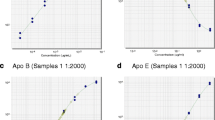Abstract
The Gyrolab™ xP is a microfluidic platform for conducting ligand binding assays (LBAs) and is recognized for its utility in discovery bioanalysis. However, few reports have focused on the technology for regulated bioanalysis. This technology has the advantage of low reagent consumption, low sample volume, and automated ligand binding methods. To improve bioanalysis testing timelines and increase the speed at which biotherapeutics are delivered to patients, we evaluated the technology for its potential to deliver high-quality data at reduced testing timelines for regulated bioanalysis. Six LBA methods were validated to support bioanalysis for GLP toxicokinetic or clinical pharmacokinetic studies. Validation, sample analysis, and method transfer are described. In total, approximately 4000 samples have been tested for regulated bioanalysis to support 6 GLP toxicology studies and approximately 1000 samples to support 2 clinical studies. Gyrolab™ xP had high run pass rates (≥83%) and high incurred sample reanalysis (ISR) pass rates (>94%). The maximum total error observed across all QC levels for a given assay was <30% for all six LBAs. High instrument response precision (CV ≤5%) was observed across compact discs (CDs), and methods were validated to use a single standard curve across multiple CDs within a Gyrolab™ xP run. Reduced bioanalysis timelines were achieved compared to standard manual plate-based methods, and methods were successfully transferred across testing labs, paving the way for this platform for use in late-stage clinical development.



Similar content being viewed by others
REFERENCES
Chow SC. Adaptive clinical trial design. Annu Rev Med. 2014;65:405–15.
Dong G. A varying-stage adaptive phase II/III clinical trial design. Stat Med. 2014;33(8):1272–87.
Hager T, Spahr C, Xu J, Salimi-Moosavi H, Hall M. Differential enzyme-linked immunosorbent assay and ligand-binding mass spectrometry for analysis of biotransformation of protein therapeutics: application to various FGF21 modalities. Anal Chem. 2013;85(5):2731–8.
Kaur S, Xu K, Saad OM, Dere RC, Carrasco-Triguero M. Bioanalytical assay strategies for the development of antibody-drug conjugate biotherapeutics. Bioanalysis. 2013;5(2):201–26.
Lee JW, Kelley M, King LE, Yang J, Salimi-Moosavi H, Tang MT, et al. Bioanalytical approaches to quantify “total” and “free” therapeutic antibodies and their targets: technical challenges and PK/PD applications over the course of drug development. AAPS J. 2011;13(1):99–110.
Umberger TS, Sloan JH, Chen J, Cheng C, Siegel RW, Qian Y, et al. Novel sandwich immunoassays for the measurement of total and active FGF21. Bioanalysis. 2014;6(24):3283–93.
Fraley KJ, Abberley L, Hottenstein CS, Ulicne JJ, Citerone DR, Szapacs ME. The Gyrolab immunoassay system: a platform for automated bioanalysis and rapid sample turnaround. Bioanalysis. 2013;5(14):1765–74.
Mora JR, Obenauer-Kutner L, Vimal PV. Application of the Gyrolab platform to ligand-binding assays: a user’s perspective. Bioanalysis. 2010;2(10):1711–5.
Yang TY, Uhlinger DJ, Ayers SA, O’Hara DM, Joyce AP. Challenges in selectivity, specificity and quantitation range of ligand-binding assays: case studies using a microfluidics platform. Bioanalysis. 2014;6(8):1049–57.
Fraser S, Dysinger M, Soderstrom C, Kuhn M, Durham R. Active glucagon-like peptide 1 quantitation in human plasma: a comparison of multiple ligand binding assay platforms. J Immunol Methods. 2014;407:76–81.
Given AM, Whalen PM, O’Brien PJ, Ray CA. Development and validation of an alpha fetoprotein immunoassay using Gyros technology. J Pharm Biomed Anal. 2012;64–65:8–15.
Liu R, Pillutla R, DeSilva B, Zhang YJ. Rapid development of multiple ‘fit-for-purpose’ assays on an automatic microfluidic system using a streamlined process in support of early biotherapeutics discovery programs. Bioanalysis. 2013;5(14):1751–63.
Roman J, Qiu J, Dornadula G, Hamuro L, Bakhtiar R, Verch T. Application of miniaturized immunoassays to discovery pharmacokinetic bioanalysis. J Pharmacol Toxicol Methods. 2011;63(3):227–35.
Liu XF, Wang X, Weaver RJ, Calliste L, Xia C, He YJ, et al. Validation of a Gyrolab assay for quantification of rituximab in human serum. J Pharmacol Toxicol Methods. 2012;65(3):107–14.
Magana I, Macaraeg CR, Zhang L, Ma M, Thway TM. Validation of a microfluidic platform to measure total therapeutic antibodies and incurred sample reanalysis performance. Bioanalysis. 2014;6(19):2623–33.
Andersson P, Jesson G, Kylberg G, Ekstrand G, Thorsen G. Parallel nanoliter microfluidic analysis system. Anal Chem. 2007;79(11):4022–30.
Verch T, Bakhtiar R. Miniaturized immunoassays: moving beyond the microplate. Bioanalysis. 2012;4(2):177–88.
FDA. Guidance for industry: bioanalytical method validation 2001. Available from: http://www.fda.gov/downloads/Drugs/Guidances/ucm070107.pdf.
FDA. Guidance for industry: bioanalytical method validation. Draft 2013.
Fluhler E, Vazvaei F, Singhal P, Vinck P, Li W, Bhatt J, et al. Repeat analysis and incurred sample reanalysis: recommendation for best practices and harmonization from the global bioanalysis consortium harmonization team. AAPS J. 2014;16(6):1167–74.
DeSilva B, Smith W, Weiner R, Kelley M, Smolec J, Lee B, et al. Recommendations for the bioanalytical method validation of ligand-binding assays to support pharmacokinetic assessments of macromolecules. Pharm Res. 2003;20(11):1885–900.
Thway TM, Ma M, Lee J, Sloey B, Yu S, Wang YM, et al. Experimental and statistical approaches in method cross-validation to support pharmacokinetic decisions. J Pharm Biomed Anal. 2009;49(3):613–8.
Agency EM. Guideline on bioanalytical method validation. 2011.
Author information
Authors and Affiliations
Corresponding author
Electronic Supplementary Material
Below is the link to the electronic supplementary material.
Supplemental Figure 1
The method Total Error (%) for all LBAs validated on the Gyrolab™ xP workstation. Six QC for each LBA are plotted that includes LLOQ, LQC, MQC, HQC, ULOQ and DilQC. % Total Error = |%Dev| + Total %CV. (DOCX 125 kb)
Supplemental Table S1
(DOCX 13 kb)
Supplemental Table S2
(DOCX 13 kb)
Rights and permissions
About this article
Cite this article
Liu, R., Hoffpauir, B., Chilewski, S.D. et al. Accelerating Regulated Bioanalysis for Biotherapeutics: Case Examples Using a Microfluidic Ligand Binding Assay Platform. AAPS J 19, 82–91 (2017). https://doi.org/10.1208/s12248-016-0006-z
Received:
Accepted:
Published:
Issue Date:
DOI: https://doi.org/10.1208/s12248-016-0006-z




